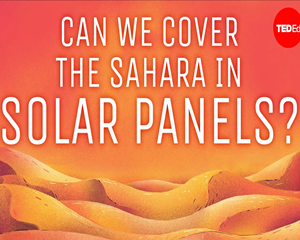Every day, the sands of the Sahara Desert reach temperatures up to 80 degrees Celsius.
每天,撒哈拉沙漠的地表温度高达80摄氏度。
Stretching over roughly nine million square kilometers, this massive desert receives about 22 million terawatt hours of energy from the Sun every year.
这片巨大的沙漠绵延面积约九百万平方千米,每年能从太阳接收2200万兆瓦时的能量。
That's well over 100 times more energy than humanity consumes annually.
这可比人类每年消耗的能源多出100倍之多。
So, could covering the desert with solar panels solve our energy problems for good?
那么,我们能通过将这片沙漠覆盖太阳能板,永远解决能源问题吗?
Solar panels work when light particles hit their surface with enough energy to knock electrons out of their stable bonds.
太阳能板若要起作用,则必须要有带足够能量的光子撞击表面,使电子成为不稳定的状态。
On their journey back to stability, these electrons produce electricity.
在电子回归稳定的过程,它们就会释出电能。
However, there's a limit to how much power panels can generate.
但是太阳能板能产出的能源是有上限的。
Solar panels can only interact with certain wavelengths of light, making it impossible to convert over half the sunlight they receive.
由于太阳能板只会对特定波长的光起反应,导致过半接收的阳光无法转换能量。
And even light particles they can convert often bounce off them without ever hitting an electron.
就连能够转换的光子,也时常在撞击电子之前就从太阳能板上弹开。
But thanks to clever scientists and engineers and substantial government investment, solar panels are generating more electricity than ever.
拜聪明的科学家和工程师的努力,加上政府大量的资金帮助,现在的太阳能板比以往产出更多的电能。
Anti-reflective coatings and patterns on the panels' surface create more opportunities for incoming light particles to hit electrons.
面板上的抗反射涂层和图样,使得前来的光子更有机会撞击电子。
These techniques have increased commercial solar panel efficiency from the low-teens to 25%, with experimental models reaching up to 47%.
这些技术让商业太阳能板的发电效率从原本的低于10%提升到25%,实验性的模型甚至高达47%。
What's more, solar has gotten 89% cheaper over the last decade, thanks in part to global supply chains for other technologies that use the same materials.
此外,太阳能的价格比起过去十年低了89%,这都要归功于全球供应链中许多的科技都使用了相同的材料。
Together, these factors have made solar power the cheapest source of electricity on Earth.
综合以上原因,太阳能成为了地球上最便宜的能源。
Countries including India, China, Egypt, and the US, have already taken these new panels into the desert.
像是印度、中国、埃及和美国等国家,早已将新型太阳能板置于沙漠当中。

Their massive solar farms range from 15 to 56 square kilometers,
这些太阳能发电厂面积约15到56平方公里不等,
and when the sun is high in the sky, these plants can provide energy for hundreds of thousands of local residents.
当太阳高挂空中时,这些电厂将供给当地数十万馀的居民用电。
But these farms also get extremely hot.
但同时这些区域也异常炎热。
Light that solar cells don't convert or reflect is absorbed as heat, which reduces a panel's efficiency.
那些无法为太阳能板转换或是反射的光被作为热能吸收,导致太阳能板的效率降低。
And the cooling systems employed by many farms can use huge amounts of energy powering fans or moving water to maintain optimal temperatures.
而许多电厂使用的冷却系统,如电风扇或是流水,都需耗费大量能源维持适当的温度。
Even with these systems, solar panels in the desert absorb far more heat than the natural sandy environment.
即便有了这些系统,在沙漠中的太阳能板吸收的热能仍远比原生沙地环境还多。
This hasn't been a problem on the scale of existing solar farms.
对现存规模的太阳能发电厂而言,这还不构成问题。
But if we tried to cover the Sahara, this effect could create massive changes in the region's climate.
但我们若是要覆盖整个撒哈拉沙漠,则会让当地的气候产生巨变。
Constructing solar farms already disrupts local ecosystems, but a plant of this scale could dramatically transform the desert landscape.
光是架设太阳能发电厂就已破坏当地的生态系统,何况是此等规模的发电厂,这必然巨幅改变沙漠的景观。
Thankfully, solar panels aren't our only option. And some of the largest solar plants in the world are trying a new approach: giant mirrors.
幸好,太阳能板并非唯一的选项。世界上一些大型的大阳能电厂正尝试一个全新的方案:巨大的镜子。
Morocco's Noor Power Plant, which will eventually cover roughly 30 square kilometers of the Sahara, is a concentrated solar power plant.
位于摩洛哥的诺尔发电厂,是一座密集型的太阳能发电厂,最终它将覆盖撒哈拉沙漠约30平方公里的土地。
This design reflects light onto a receiver, which converts that energy to heat, and then electricity.
这个设计会反射阳光给接收器,将其能量转换成热能,最后由热能产生电力。
These mirrors still create a dangerous temperature shift for local wildlife, but they have less potential to transform the landscape.
这些镜子产生的热能转移,对当地的野生动物而言仍然危险,但是这个方法较不会改变沙漠的景观。
And since it takes time for the materials being heated to cool off, these plants often continue producing electricity past sunset.
由于加热的太阳能板需要时间冷却,这些发电厂即使在日落后通常还能继续发电。
Whether they use panels or mirrors, industrial solar farms are often easy to fit into existing energy infrastructure.
不论是用板子或是镜子,工业用的太阳能发电厂都能轻易地与现存的能源建设结合。
However, getting their electricity beyond local power grids is much more difficult.
然而,在当地能源运输网之外取得电力是十分困难的事。
Some countries are working on ways to connect electric grids across the globe.
部分国家正尝试不同的方法,例如将全球的电力运输网连结。
And many farm store energy in massive batteries, or convert their electricity into clean gas that can be used later.
有的将能源储存在一个巨大的电池里,或是将电力转换成干净的燃气供未来随时使用。
But right now, these techniques are still too expensive and inefficient to rely on.
但目前这些技术仍因费用较高且效率低落,所以不太可靠。
Worse still, industrial renewables can share some of the same problems as fossil fuels,
更糟的是,工业再生能源与化石燃料有共通的缺点,
relying on destructive mining operations and carbon-emitting global supply chains.
两者的开发过程都具破坏性,以及全球供应链的碳排放。
Fortunately, solar can exist on many scales, from industrial solar farms to smaller installations that power individual buildings and rural communities.
值得庆幸的是,太阳能发电的规模可大可小,从大型的发电厂,小至安装在个人住宅以及偏远社区的家户用电。
These projects can supplement energy use or provide a passive source of energy for regions off the grid.
这些项目除了能增加可用的能源,在供电网之外的地区也能有被动能源供给。
And since solar panels rely on a few simple components, they're quick to install and relatively easy to update.
因为太阳能板由一些简易的零件组成,它们可以迅速安装,也能够容易更新。
In fact, it's this flexibility that enabled solar to become so cheap and ubiquitous over the last decade.
事实上,这也是自上个十年以来太阳能板变得如此便宜且普及的原因。
So if we want to keep up with humanity's rising energy use, we'll need answers both big and small.
因此,如果我们要跟上人类与日俱增的能源消耗,太阳能板的配置势必要双管齐下。












